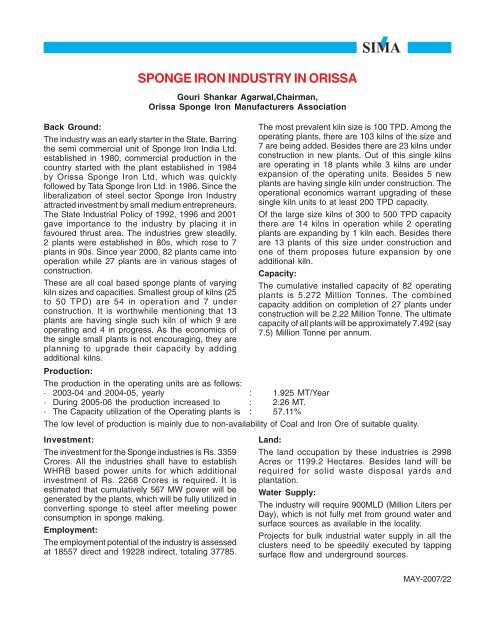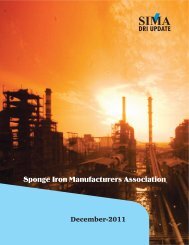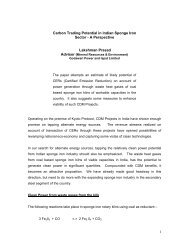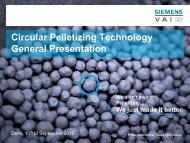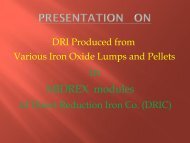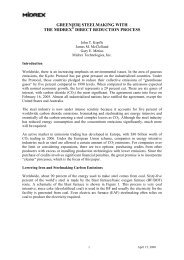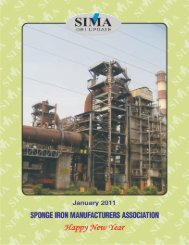Create successful ePaper yourself
Turn your PDF publications into a flip-book with our unique Google optimized e-Paper software.
SPONGE IRON INDUSTRY IN ORISSA<br />
Back Ground:<br />
The industry was an early starter in the State. Barring<br />
the semi commercial unit of Sponge Iron India Ltd.<br />
established in 1980, commercial production in the<br />
country started with the plant established in 1984<br />
by Orissa Sponge Iron Ltd, which was quickly<br />
followed by Tata Sponge Iron Ltd. in 1986. Since the<br />
liberalization of steel sector Sponge Iron Industry<br />
attracted investment by small medium entrepreneurs.<br />
The State Industrial Policy of 1992, 1996 and 2001<br />
gave importance to the industry by placing it in<br />
favoured thrust area. The industries grew steadily.<br />
2 plants were established in 80s, which rose to 7<br />
plants in 90s. Since year 2000, 82 plants came into<br />
operation while 27 plants are in various stages of<br />
construction.<br />
These are all coal based sponge plants of varying<br />
kiln sizes and capacities. Smallest group of kilns (25<br />
to 50 TPD) are 54 in operation and 7 under<br />
construction. It is worthwhile mentioning that 13<br />
plants are having single such kiln of which 9 are<br />
operating and 4 in progress. As the economics of<br />
the single small plants is not encouraging, they are<br />
planning to upgrade their capacity by adding<br />
additional kilns.<br />
Gouri Shankar Agarwal,Chairman,<br />
Orissa Sponge Iron Manufacturers Association<br />
The most prevalent kiln size is 100 TPD. Among the<br />
operating plants, there are 103 kilns of the size and<br />
7 are being added. Besides there are 23 kilns under<br />
construction in new plants. Out of this single kilns<br />
are operating in 18 plants while 3 kilns are under<br />
expansion of the operating units. Besides 5 new<br />
plants are having single kiln under construction. The<br />
operational economics warrant upgrading of these<br />
single kiln units to at least 200 TPD capacity.<br />
Of the large size kilns of 300 to 500 TPD capacity<br />
there are 14 kilns in operation while 2 operating<br />
plants are expanding by 1 kiln each. Besides there<br />
are 13 plants of this size under construction and<br />
one of them proposes future expansion by one<br />
additional kiln.<br />
Capacity:<br />
The cumulative installed capacity of 82 operating<br />
plants is 5.272 Million Tonnes. The combined<br />
capacity addition on completion of 27 plants under<br />
construction will be 2.22 Million Tonne. The ultimate<br />
capacity of all plants will be approximately 7.492 (say<br />
7.5) Million Tonne per annum.<br />
Production:<br />
The production in the operating units are as follows:<br />
· 2003-04 and 2004-05, yearly : 1.925 MT/Year<br />
· During 2005-06 the production increased to : 2.26 MT.<br />
· The Capacity utilization of the Operating plants is : 57.11%<br />
The low level of production is mainly due to non-availability of Coal and Iron Ore of suitable quality.<br />
Investment:<br />
The investment for the Sponge industries is Rs. 3359<br />
Crores. All the industries shall have to establish<br />
WHRB based power units for which additional<br />
investment of Rs. 2268 Crores is required. It is<br />
estimated that cumulatively 567 MW power will be<br />
generated by the plants, which will be fully utilized in<br />
converting sponge to steel after meeting power<br />
consumption in sponge making.<br />
Employment:<br />
The employment potential of the industry is assessed<br />
at 18557 direct and 19228 indirect, totaling 37785.<br />
Land:<br />
The land occupation by these industries is 2998<br />
Acres or 1199.2 Hectares. Besides land will be<br />
required for solid waste disposal yards and<br />
plantation.<br />
Water Supply:<br />
The industry will require 900MLD (Million Liters per<br />
Day), which is not fully met from ground water and<br />
surface sources as available in the locality.<br />
Projects for bulk industrial water supply in all the<br />
clusters need to be speedily executed by tapping<br />
surface flow and underground sources.<br />
MAY-<strong>2007</strong>/22


